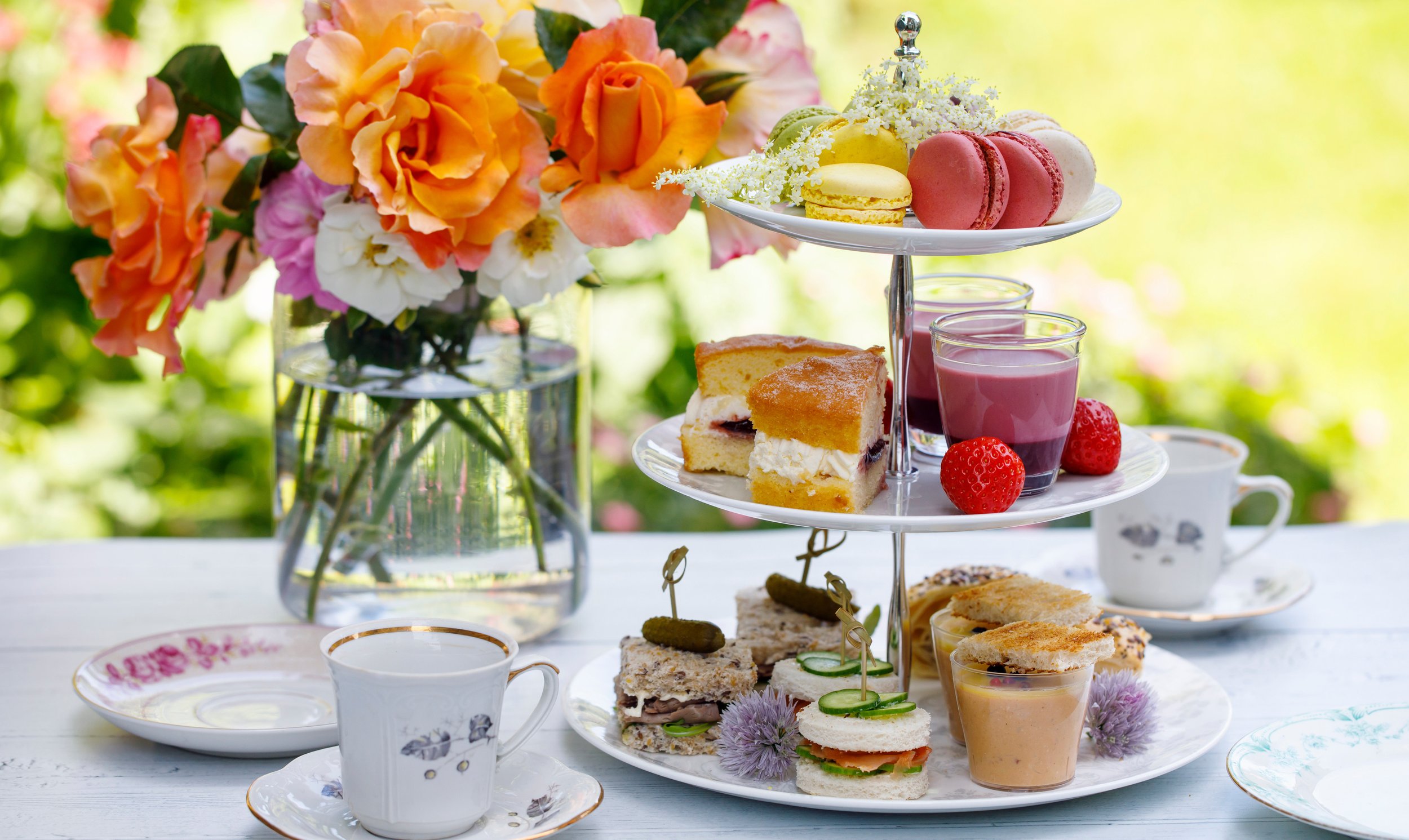Host Your Own Tea Party - Ideas and Tips
Having a Tea Party is fun, indulgent, and fulfilling. It’s a wonderful way to either connect with old friends or make new ones. The act of inviting people into your home and preparing something for them that is elegant, refined, delicious, and beautiful is an art that we have long neglected for the ease and convenience of dining in restaurants. One of the most important things about having a tea party is the opportunity to bring beauty into your life. The preparation should be fun and creative. You are not only surrounding yourself with beautiful things but also nurturing people you care about and creating an experience for them that will hopefully be relaxing and inspiring. Here are ten things to consider as you begin to plan your tea party.
1. The Guest List:
Probably the most important thing about your Tea Party will be who you choose to invite. Choose people you feel will find each other interesting but may not necessarily know each other in everyday life. Avoid inviting two people that are already close if you are going to try to mix up the guests, as they may tend to talk about things that the others don’t find interesting, and share insider “jokes” or otherwise pair up. The perfect number of people is between 4 and 8. This allows time for conversation but also allows someone to sit quietly for a few moments if they’d like to. Most importantly, the perfect number of guests is the number you can comfortably fit at your table. If you have an empty place at the table, remove the chair and keep it out of sight. If you are planning a tea party for an occasion, there are some additional considerations: see our blog post for “Tips for Tea Party Occasions.”
2. Invitations:
Printed invitations mailed via the post office are the most elegant; however, in today’s digital world, you can certainly invite your guests by using email. Craft an invitation yourself and send it individually for a personal touch. Though the evite apps might be useful for a large, occasion-driven tea party, such as a baby shower, sometimes those can be filtered into the junk folder and are far less intimate. Be sure in your invitation to reference the type of dress you would like the people to wear, with phrases like: “No need to dress up; this is a relaxing and comfortable Tea Party,” or, “Put on your pretty dress, hat, and gloves and come share an afternoon at my Tea Party” ask for an RSVP, and include a line “please let me know if you have any dietary restrictions” if you do not already know them. Of course, include both the start and end times of the event. Consider the start time to be an “arrival” time and plan to seat and serve about 30 minutes after that. The perfect Afternoon Tea Party is about 1 ½ - 2 hours long
3. Atmosphere:
Not many of us have grand parlors in today’s world, so your tea party will most likely be at your dining table. Making sure that things are neat, clean, and tidy will add a feeling of peace and relaxation. Simplify the area as much as you can so people are not distracted and keep their focus on the table. Make sure your guest restroom is clean and ready for guests, and a lit candle in the bathroom is always a nice touch. Candles are not traditionally placed on the Afternoon Tea table, but candles in the area can be nice. Having music is a personal choice; for a traditional tea, choose a quietly played Baroque or classical playlist, or, if your group would prefer something else, that’s fine too. Remember that the music should lend itself to a refined and relaxing atmosphere and not be intrusive or limit conversation.
4. Teaware and Table Settings:
There’s no need to buy fancy teaware and silverware to have a nice tea party, but there is nothing more beautiful than a table dressed for tea. If you don’t own a complete set of Grandma’s China, purchasing mismatched teacups at a local flea market is a fun challenge and makes the table look lovely and eclectic. However, teacups should always have a saucer, or how else will the lovely sound of clinking China be accomplished? There should be a teacup and saucer at each setting, with the handle turned to 4 o’clock, a small salad plate, napkin, fork, spoon, knife, and a small glass of cold water. The table should be set in a way that is easy to set your trays of food onto the table. You can use either a tiered tray or separate pretty plates of your teatime treats. Be sure to include little tongs, so people do not need to touch all the food.
5. Flowers:
Fresh flowers are an important part of any tea table. Of course, it’s easiest to purchase some flowers from your local florist, but there’s no need to purchase an expensive floral centerpiece. Using flowers or greens from your garden makes even better decorations than something premade. In winter, things like pinecones can be used as place markers, and sprigs of greenery can be tied around the napkin to give it a little extra beauty. Fresh flowers from your garden can always be used to make a seasonal bouquet. If you don’t have a garden, consider taking a little time in the days leading up to the tea party to take a walk around the neighborhood or a short hike to collect things to help decorate. Remember, never cut anything from anyone’s garden without permission or from public lands. But sometimes mother nature will give you the perfect gifts, just lying on the ground: things like cottonwood branches, pinecones, stones, etc. Make sure you are gathering with gratitude and in a place where it is allowed.
6. The Menu:
Traditionally, small finger foods are served during teatime. Thankfully, you can prepurchase many of the items or make them yourself if you love to cook. Tea sandwiches are easy to make; use fresh bread, make the sandwich, and then cut the crusts off and cut into squares. Tiny sandwiches dry out quickly, so make these last and cover with a moistened paper towel until service. Scones are another necessity, along with clotted cream and lemon curd. Usually, there are one to two sweets, a small cake, or cookies. Fresh fruit is a lovely garnish, even on a simple treat such as a brownie square with a single fresh raspberry on top. Fresh herbs or flowers are lovely ways to garnish your plates. Your food offerings should be both beautiful and delicious. Your guests should leave feeling satiated and indulged, but not overfull. This is not a full meal, but just a special treat.
7. Food Allergies and Preferences:
It seems like in today’s modern world, everyone has some kind of self-imposed food restrictions. When making your menu, keep in mind that you might have vegetarians, vegans, or gluten-free guests. However, the whole point of a tea party is INDULGENCE, so people may be willing to eat things, especially in little teatime bites, that they might not otherwise be willing to eat. Still, be sure to have some fresh fruit, some vegetarian finger sandwiches, and some gluten-free choices.
8. Tea:
Let’s not forget the most important guests at the table, the Teapot and the TEA. There are a number of ways to do this: if you do not have serving help, then make the tea in teapots and bring it to the table brewed. There should be one teapot for every three guests. If you would like to offer different styles of tea, that’s lovely, but in most cases, people will be happy with your selection. Afternoon teas are usually accompanied by a traditional black tea, one that can be savored alone or with the addition of milk and sugar. Allow guests to serve themselves so that once you yourself have been seated at the table, you can enjoy the conversation without having to get up and serve. A bit of advice: Use a Tea Cozy. A traditional tea cozy is usually a little quilted cover, or hat, that goes over the teapot to keep it warm. If you do not have one, use a clean and pretty kitchen or tea towel to wrap around the teapots to keep them warm for longer.
9. Ending the Party:
As your party begins to draw to a close, subtly begin to clear the table about 15 minutes before the end time. Remember, it’s best to end the event while people are still having a good time. Do not allow guests to help you clean up, no matter how much they press you. Cleaning up is a time for you to cherish the washing up of your teaware and to think about your tea party and how it all went, and it should be done when all your guests leave. A good rule of thumb is never turn on the water in your sink while you still have a guest there.

